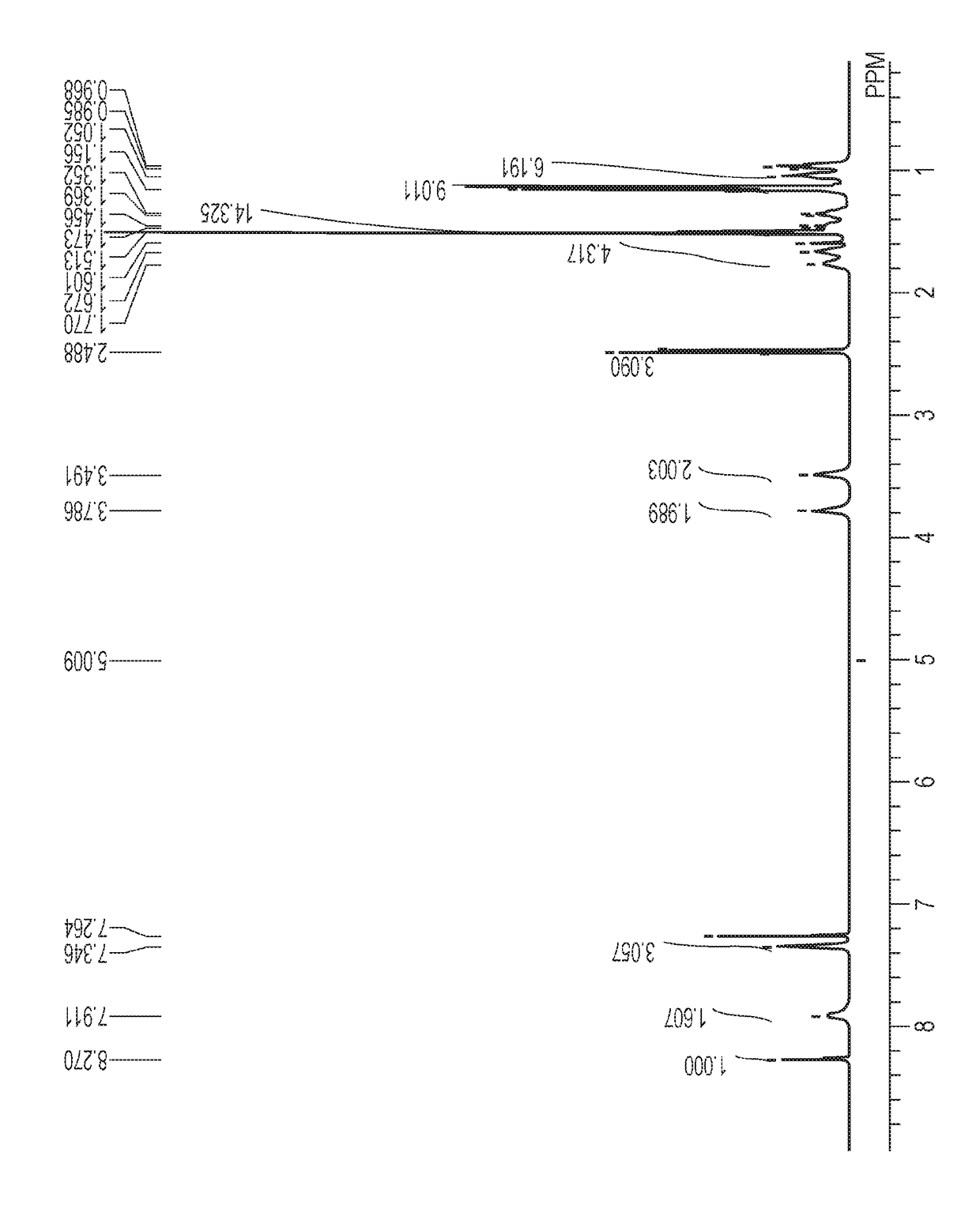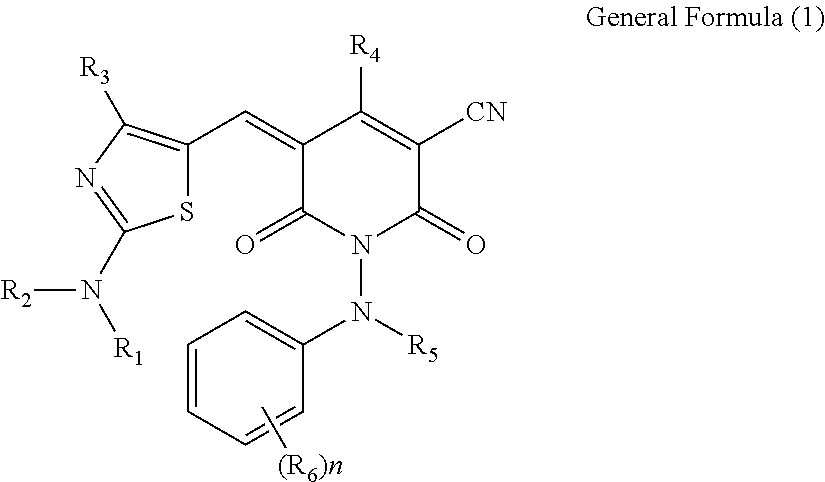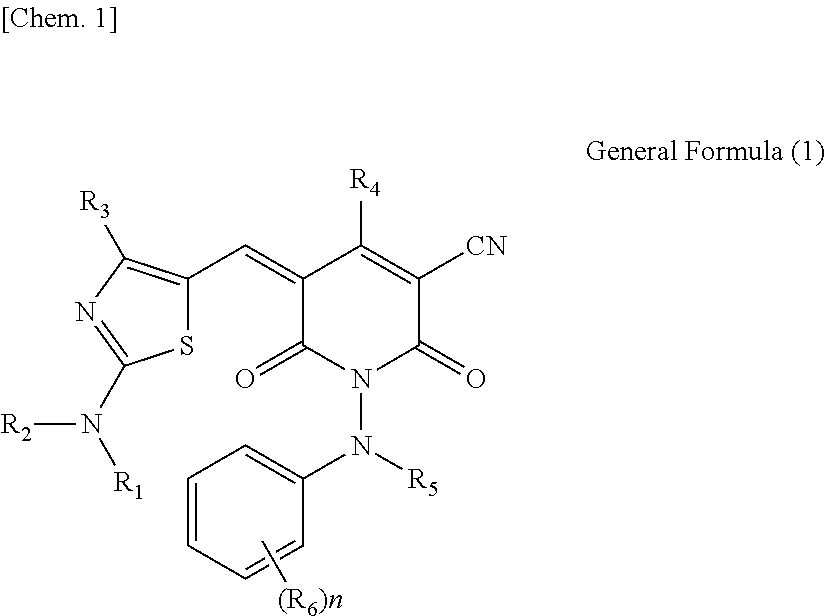Compound, ink, resist composition for color filter, thermal transfer recording sheet, and toner
a technology of resist composition and color filter, which is applied in the field of compound and toning, resist composition for color filter, thermal transfer recording sheet, and toner, can solve the problems of depolarization effect, decrease in lightness of color filter, and decrease in contrast ratio of color display of liquid crystal display, so as to and improve chroma and dispersibility
- Summary
- Abstract
- Description
- Claims
- Application Information
AI Technical Summary
Benefits of technology
Problems solved by technology
Method used
Image
Examples
example 2
Manufacturing Manufacturing of Compound (1-2)
[0150]Except that the aldehyde compound (A-2) and the pyridone compound (B-3) were used, the compound (1-2) was manufactured by a method similar to that of the manufacturing example 1 and then identified.
Analytical Result of Compound (1-2)
[0151][1]1H-NMR (400 MHz, CDCl3, room temperature): δ (ppm)=0.90-1.02 (12H, m), 1.15 (9H, s), 1.15-1.28 (10H, m), 1.51 (9H, s), 1.57 (6H, s), 1.86 (1H, br), 2.04 (1H, br), 2.49 (3H, s), 3.41 (2H, br), 3.63-3.85 (2H, m), 7.34 (3H, dd, J=3.90, 9.80 Hz), 7.91 (2H, br), 8.27 (1H, s)
[0152][2] Mass analysis (ESI-TOF): m / z=716.4571 (M+H)+
example 3
Manufacturing Manufacturing of Compound (1-5)
[0153]Except that the aldehyde compound (A-2) and the pyridone compound (B-2) were used, the compound (1-5) was manufactured by a method similar to that of the manufacturing example 1 and then identified.
Analytical Result of Compound (1-5)
[0154][1]1H-NMR (400 MHz, CDCl3, room temperature): δ (ppm)=0.89-1.01 (12H, m), 1.24-1.42 (16H, m), 1.53-1.58 (11H, m), 2.07 (3H, s), 2.53 (3H, s), 3.42 (2H, br), 3.68-3.83 (2H, br), 7.30-7.39 (3H, m), 7.60-7.81 (2H, m), 8.31 (1H, s)
[0155][2] Mass analysis (ESI-TOF): m / z=674.4120 (M+H)+
example 4
Manufacturing Manufacturing of Compound (1-8)
[0156]Except that the aldehyde compound (A-2) and the pyridone compound (B-1) were used, the compound (1-8) was manufactured by a method similar to that of the manufacturing example 1 and then identified.
Analytical Result of Compound (1-8)
[0157][1]1H-NMR (400 MHz, CDCl3, room temperature): δ (ppm)=0.89-1.01 (12H, m), 1.27-1.49 (16H, m), 1.52 (9H, d, J=16.5 Hz), 1.90-2.01 (2H, m), 2.39 (1H, s), 2.56 (2H, s), 3.37 (2H, br), 3.74 (2H, br), 7.15-7.22 (4H, m), 7.26-7.29 (2H, m), 7.42 (2H, d, J=6.90 Hz), 7.55 (1H, d, J−7.30 Hz), 7.64 (1H, s), 8.34 (1H, s)
[0158][2] Mass analysis (ESI-TOF): m / z=736.4290 (M+H)+
PUM
| Property | Measurement | Unit |
|---|---|---|
| reaction temperature | aaaaa | aaaaa |
| reaction temperature | aaaaa | aaaaa |
| melting point | aaaaa | aaaaa |
Abstract
Description
Claims
Application Information
 Login to View More
Login to View More - R&D
- Intellectual Property
- Life Sciences
- Materials
- Tech Scout
- Unparalleled Data Quality
- Higher Quality Content
- 60% Fewer Hallucinations
Browse by: Latest US Patents, China's latest patents, Technical Efficacy Thesaurus, Application Domain, Technology Topic, Popular Technical Reports.
© 2025 PatSnap. All rights reserved.Legal|Privacy policy|Modern Slavery Act Transparency Statement|Sitemap|About US| Contact US: help@patsnap.com



